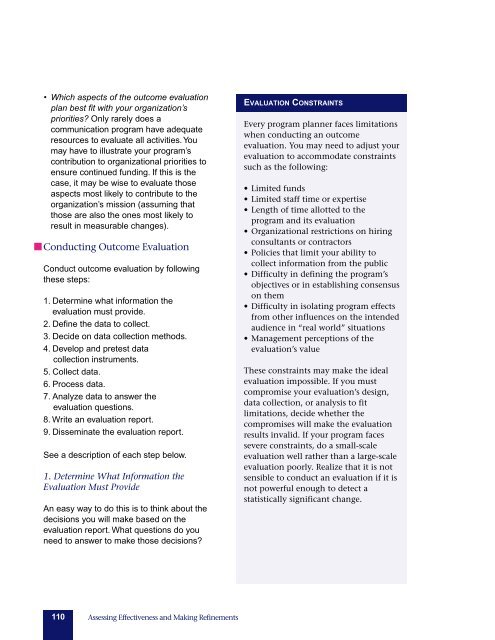pink-book
pink-book
pink-book
You also want an ePaper? Increase the reach of your titles
YUMPU automatically turns print PDFs into web optimized ePapers that Google loves.
• Which aspects of the outcome evaluation<br />
plan best fit with your organization’s<br />
priorities Only rarely does a<br />
communication program have adequate<br />
resources to evaluate all activities. You<br />
may have to illustrate your program’s<br />
contribution to organizational priorities to<br />
ensure continued funding. If this is the<br />
case, it may be wise to evaluate those<br />
aspects most likely to contribute to the<br />
organization’s mission (assuming that<br />
those are also the ones most likely to<br />
result in measurable changes).<br />
Conducting Outcome Evaluation<br />
Conduct outcome evaluation by following<br />
these steps:<br />
1. Determine what information the<br />
evaluation must provide.<br />
2. Define the data to collect.<br />
3. Decide on data collection methods.<br />
4. Develop and pretest data<br />
collection instruments.<br />
5. Collect data.<br />
6. Process data.<br />
7. Analyze data to answer the<br />
evaluation questions.<br />
8. Write an evaluation report.<br />
9. Disseminate the evaluation report.<br />
See a description of each step below.<br />
1. Determine What Information the<br />
Evaluation Must Provide<br />
An easy way to do this is to think about the<br />
decisions you will make based on the<br />
evaluation report. What questions do you<br />
need to answer to make those decisions<br />
EVALUATION CONSTRAINTS<br />
Every program planner faces limitations<br />
when conducting an outcome<br />
evaluation. You may need to adjust your<br />
evaluation to accommodate constraints<br />
such as the following:<br />
• Limited funds<br />
• Limited staff time or expertise<br />
• Length of time allotted to the<br />
program and its evaluation<br />
• Organizational restrictions on hiring<br />
consultants or contractors<br />
• Policies that limit your ability to<br />
collect information from the public<br />
• Difficulty in defining the program’s<br />
objectives or in establishing consensus<br />
on them<br />
• Difficulty in isolating program effects<br />
from other influences on the intended<br />
audience in “real world” situations<br />
• Management perceptions of the<br />
evaluation’s value<br />
These constraints may make the ideal<br />
evaluation impossible. If you must<br />
compromise your evaluation’s design,<br />
data collection, or analysis to fit<br />
limitations, decide whether the<br />
compromises will make the evaluation<br />
results invalid. If your program faces<br />
severe constraints, do a small-scale<br />
evaluation well rather than a large-scale<br />
evaluation poorly. Realize that it is not<br />
sensible to conduct an evaluation if it is<br />
not powerful enough to detect a<br />
statistically significant change.<br />
110 Assessing Effectiveness and Making Refinements


